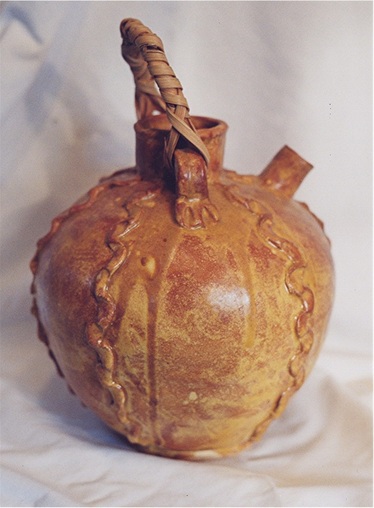Anglo-Saxon Pottery

There are very few examples of British (Celtic, as opposed to English, or Anglo-Saxon) pottery from after the Romans left Britain. The closest I've been able to get is Anglo-Saxon pottery. And it suits my methods of working.
When the Angles and Saxons left the Continent and moved into Britain, they generally left their best potters behind. Potters on the Continent were far superior to potters in Britain for several centuries. While Anglo-Saxon potters in Europe were using a fast wheel (what we would call a potter's wheel), English potters were still pinching pots or making them from coils, and possibly using a slow wheel only for decorating them.
The main forms of pottery we find today from this period are funerary urns and pots for food storage and cooking. Early cooking pots are quite small. They get larger later on, for reasons we don't understand.
Pagan Anglo-Saxons cremated their dead, then buried their ashes and bones in urns. These are the best-made pieces of pottery most settlements had. They were decorated in a number of ways, almost all abstract. Mainly, they were incised using a sharp instrument (probably bone. Wood leaves a raised edge when it cuts through clay, and this is a nuisance. It means going back over your work and cleaning it, making it a two-stage process. Bone cuts through smoothly). The potter also used stamps made of carved bone. And they would push the walls of the pot either in or out in places to create bosses. Some of these urns are wild and creative in their use of decoration. (Once they converted to Christianity, Anglo-Saxons buried their dead)
I make small drinking beakers out of clay. They're pinched, as the Anglo-Saxons would have done, with a swollen belly and flared lip. I incise decoration using a metal dental tool. Their pots were unglazed, or had natural glazes where ashes fell on the outside of the pots. I glaze mine on the inside, for hygienic reasons. I use either a clear or a green-gold commercial glaze.
I also make spouted pitchers based on a style used in England before the 10th century (the photo in the upper left is one of mine). Early jugs had cylindrical spouts added to them, unlike hand-made pitchers today which have a pulled lip along the top rim. These early pitchers also had small handles at the top, usually two or three. Three was most common. But where there are only two, they're on the sides of the jug, not at the back as we would expect. After I thought about this for a while, I realized that the jugs must have had wooden, rope or wicker handles that have long ago rotted away. They were designed to be lifted up, then tipped ("pitched", hence, possibly, the word "pitcher") to pour, as a bucket is tipped to pour. I make my own wicker handles.
The decoration on the outside of the jug is a thin strip of damp clay attached to the outside, then "thumbed" from side to side to create a wavy design. This is authentic, as are the proportions, the top, spout and lugs. However, this jug is made from medium-fired stoneware clay with a commercial lead-free glaze.
The great thing about this design (and I can take no credit. I just recognized a good one when I saw it!) is that there's always air pressure going in the top as the liquid pours out the spout. So it's a steady even pour, with none of that "glug glug" you get with bottles.
I generally glaze these, inside and out, with the same green-gold glaze. It's the closest thing I can find in a commercial glaze to the lead glaze early medieval potters used. Their glaze was just powdered galena (lead ore) sifted onto thes urface of the damp pot. Well, I'm sorry, I'm not about to shake powdered lead all over my workshop just to be authentic. So I use non-lead glazes.
The best way to describe the colour of their lead glazes is "snot green." It's slimy and glossy, but in places it's runny or matte, and it ranges from bright yellow through gold to green.
They glazed pots only on the outside. I glaze mine inside as well, for reasons of hygiene.
When the Angles and Saxons left the Continent and moved into Britain, they generally left their best potters behind. Potters on the Continent were far superior to potters in Britain for several centuries. While Anglo-Saxon potters in Europe were using a fast wheel (what we would call a potter's wheel), English potters were still pinching pots or making them from coils, and possibly using a slow wheel only for decorating them.
The main forms of pottery we find today from this period are funerary urns and pots for food storage and cooking. Early cooking pots are quite small. They get larger later on, for reasons we don't understand.
Pagan Anglo-Saxons cremated their dead, then buried their ashes and bones in urns. These are the best-made pieces of pottery most settlements had. They were decorated in a number of ways, almost all abstract. Mainly, they were incised using a sharp instrument (probably bone. Wood leaves a raised edge when it cuts through clay, and this is a nuisance. It means going back over your work and cleaning it, making it a two-stage process. Bone cuts through smoothly). The potter also used stamps made of carved bone. And they would push the walls of the pot either in or out in places to create bosses. Some of these urns are wild and creative in their use of decoration. (Once they converted to Christianity, Anglo-Saxons buried their dead)
I make small drinking beakers out of clay. They're pinched, as the Anglo-Saxons would have done, with a swollen belly and flared lip. I incise decoration using a metal dental tool. Their pots were unglazed, or had natural glazes where ashes fell on the outside of the pots. I glaze mine on the inside, for hygienic reasons. I use either a clear or a green-gold commercial glaze.
I also make spouted pitchers based on a style used in England before the 10th century (the photo in the upper left is one of mine). Early jugs had cylindrical spouts added to them, unlike hand-made pitchers today which have a pulled lip along the top rim. These early pitchers also had small handles at the top, usually two or three. Three was most common. But where there are only two, they're on the sides of the jug, not at the back as we would expect. After I thought about this for a while, I realized that the jugs must have had wooden, rope or wicker handles that have long ago rotted away. They were designed to be lifted up, then tipped ("pitched", hence, possibly, the word "pitcher") to pour, as a bucket is tipped to pour. I make my own wicker handles.
The decoration on the outside of the jug is a thin strip of damp clay attached to the outside, then "thumbed" from side to side to create a wavy design. This is authentic, as are the proportions, the top, spout and lugs. However, this jug is made from medium-fired stoneware clay with a commercial lead-free glaze.
The great thing about this design (and I can take no credit. I just recognized a good one when I saw it!) is that there's always air pressure going in the top as the liquid pours out the spout. So it's a steady even pour, with none of that "glug glug" you get with bottles.
I generally glaze these, inside and out, with the same green-gold glaze. It's the closest thing I can find in a commercial glaze to the lead glaze early medieval potters used. Their glaze was just powdered galena (lead ore) sifted onto thes urface of the damp pot. Well, I'm sorry, I'm not about to shake powdered lead all over my workshop just to be authentic. So I use non-lead glazes.
The best way to describe the colour of their lead glazes is "snot green." It's slimy and glossy, but in places it's runny or matte, and it ranges from bright yellow through gold to green.
They glazed pots only on the outside. I glaze mine inside as well, for reasons of hygiene.


